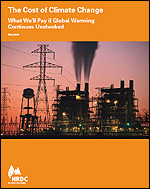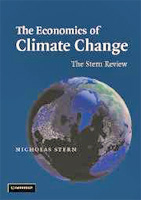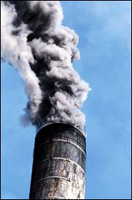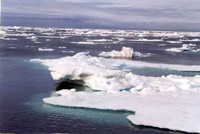
Addressing Climate Change
Climate Research Archive
Internet Tech Holds Climate Potential
According to a June 2008 study by WWF Canada, in conjunction with Bell Canada, making better use of Communications Technology (ICT) could reduce Canada's greenhouse gas (GHG) emissions by 20 million tonnes a year. The report argues that more aggressive implementation could yield reductions as high as 36 million tonnes a year - a realistic and achievable target in a 2020 timeframe. The emissions reductions identified in Innovating Toward a Low-Carbon Canada: Using Technology to Transform Tomorrow come from energy efficiency and enhanced use of ICT products and services - information and communications networks, software, hardware, and broadband services. In the report, WWF Canada makes concrete recommendations for business, government and the ICT sector, including:
The cost savings to businesses, government and individuals from actions outlined in the report are estimated at $7.5 billion - $13 billion per year. View June 19, 2008 WWF Canada press releaseView Executive Summary of WWF report, Innovating toward a low-carbon Canada: Using technology to transform tomorrow (pdf version)  Download full WWF report, Innovating toward a low-carbon Canada: Using technology to transform tomorrow (PDF) Download full WWF report, Innovating toward a low-carbon Canada: Using technology to transform tomorrow (PDF) Download information about methodologies used to write WWF Canada report (PDF) Download information about methodologies used to write WWF Canada report (PDF)Source: WWF Canada
US Climate Inaction Has Staggering Consequences A new report commissioned by the Natural Resources Defense Council (NRDC) and released May 22, 2008 reveals that if the US does nothing to address climate change, it would result in staggering costs to the country's economy.
A new report commissioned by the Natural Resources Defense Council (NRDC) and released May 22, 2008 reveals that if the US does nothing to address climate change, it would result in staggering costs to the country's economy. In The Cost of Climate Change - What We'll Pay if Global Warming Continues Unchecked, researchers at Tufts University present two ways of estimating the costs of climate change inaction. A comprehensive estimate, based on state-of-the-art computer modeling, finds that doing nothing will cost the United States economy more than 3.6 percent of its GDP by 2100. That is approximately $3.8 trillion dollars annually (in today's dollars). In contrast, a detailed, bottom-up analysis finds that just four categories of global warming impacts - hurricane damage, real estate losses, increased energy costs and water costs - add to a price tag of 1.8 percent of US GDP by 2100, or almost $1.9 trillion annually (in today's dollars). View May 22, 2008 NRDC press release View NRDC webpage and report, The Cost of Climate Change - What We'll Pay if Global Warming Continues Unchecked Similar to northern US states, Manitoba is at risk of significant shifts in average temperatures and increased extreme weather events as a result of climate change. This could impact our provincial economy and result in economic, social and environmental costs -unless substantive actions are taken to address the global climate crisis. Source: Natural Resources Defense Council
Human Solidarity in a Divided WorldThe Human Development Report 2007/2008 shows that climate change is not just a future scenario. Increased exposure to droughts, floods and storms is already destroying opportunity and reinforcing inequality. Meanwhile, there is now overwhelming scientific evidence that the world is moving towards the point at which irreversible ecological catastrophe becomes unavoidable. Looking to the future, no country - however wealthy or powerful - will be immune to the impact of global warming. Download Human Development Report 2007/2008
Fighting climate change: Human solidarity in a divided world (PDF) Download Human Development Report 2007/2008
Fighting climate change: Human solidarity in a divided world (PDF)View UN Human Development Reports page and background papers Hansen Research Indicates Warming Underestimated New research published by Dr. James Hansen, head of the NASA Goddard Institute for Space Studies in New York, warns the world may have grossly underestimated the scale of global warming. Dr. Hansen, who co-authored the research with eight other climate scientists, is calling for world leaders to urgently rethink targets for cutting carbon dioxide in the atmosphere. As an example, Hansen says the EU target of 550 parts per million of C02 - the most stringent in the world - should be slashed to 350ppm.
New research published by Dr. James Hansen, head of the NASA Goddard Institute for Space Studies in New York, warns the world may have grossly underestimated the scale of global warming. Dr. Hansen, who co-authored the research with eight other climate scientists, is calling for world leaders to urgently rethink targets for cutting carbon dioxide in the atmosphere. As an example, Hansen says the EU target of 550 parts per million of C02 - the most stringent in the world - should be slashed to 350ppm.If humanity wishes to preserve a planet similar to that on which civilization developed and to which life on Earth is adapted, paleoclimate evidence and ongoing climate change suggest that CO2 will need to be reduced from its current 385 ppm to at most 350 ppm.
In contrast to other studies that use theoretical models to estimate sensitivity of the climate, Dr. Hansen's team turned to evidence from Earth's history, studying core samples taken from the bottom of the ocean, which permits examination of C02 levels dating back millions of years. Dr. Hansen's research was partly motivated by a desire to better understand and account for what he calls "slow feedback" mechanisms. These mechanisms amplify the rise in temperature caused by increasing the concentration of greenhouse gases. For instance, ice and snow reflect sunlight but when they melt, they leave exposed ground, which absorbs more heat. As ice sheets recede, the warming effect is compounded. Satellite technology available over the past three years has shown that the ice sheets are melting much faster than expected, with Greenland and west Antarctica both losing mass.  Download April 7, 2008 paper by Dr. James Hansen et. al. Target atmospheric CO2: Where should humanity aim?(PDF) Download April 7, 2008 paper by Dr. James Hansen et. al. Target atmospheric CO2: Where should humanity aim?(PDF) Download supporting material for Target atmospheric CO2 (PDF) Download supporting material for Target atmospheric CO2 (PDF)Sources: Guardian UK article (April 7, 2008) GHGs Greater Than Predicted - Earth Policy Institute A recent Earth Policy Institute report states carbon dioxide (CO2) emissions are currently exceeding the worst-case scenario laid out in 2000 by the Intergovernmental Panel on Climate Change (IPCC). A recent Earth Policy Institute report states carbon dioxide (CO2) emissions are currently exceeding the worst-case scenario laid out in 2000 by the Intergovernmental Panel on Climate Change (IPCC). With current trends well above worst-case scenario, we can expect temperature and sea level rise will likely do the same. The report states CO2 emissions are now accelerating despite unequivocal evidence that carbon dioxide is warming the planet and disrupting ecosystems around the globe. Carbon dioxide and other greenhouse gases have already raised global average temperature by 0.8 degrees Celsius, with more than two thirds of that increase since 1980. Ice core records indicate there is more CO2 in the atmosphere now than at any point in the last 650,000 years. Between 2000 and 2007, atmospheric CO2 concentration grew by an average of 2ppm per year, the fastest seven-year increase since continuous monitoring began in 1959. Rapids industrialization throughout Asia has resulted in CO2 emissions growing five times faster than the rest of the world. India's emissions have tripled since 1981 and China's have more than doubled since 1990. Analysts expect China will overtake the United States to become the world's largest emitter before 2009. In Plan B 3.0: Mobilizing to Save Civilization, Lester R. Brown outlined a plan with energy efficiency measures, technologies, and programs to protect the world's forests, which could cut net global carbon dioxide emissions 80 percent by 2020. Putting this plan into action would halt and reverse growing carbon dioxide emissions and avoid a trajectory of increased temperatures. View April 9, 2008 Earth Policy Institute article  Download IPCC Special Emissions Scenarios, 2000 (PDF) Download IPCC Special Emissions Scenarios, 2000 (PDF)View Plan B 3.0: Mobilizing to Save Civilization by Lester R. Brown Sources: Earth Policy Institute, IPCC, Lester R. Brown National Tax and Trade on Carbon - Best Option The Conference Board of Canada, an independent economic think-tank, released Use Green Taxes and Market Instruments to reduce Greenhouse Gas Emissions. The report indicates 'green taxes' accompanied by a cap and trade system will establish a price on pollution and create incentives to change the behavior of individuals and firms. The Conference Board of Canada, an independent economic think-tank, released Use Green Taxes and Market Instruments to reduce Greenhouse Gas Emissions. The report indicates 'green taxes' accompanied by a cap and trade system will establish a price on pollution and create incentives to change the behavior of individuals and firms.Canada produces 2 percent of the world's annual GHG emissions, and the levels are 32.7 percent higher than the Kyoto benchmark set for Canada. The report indicates Canada must act with "decisive domestic policy action and a commitment to develop and deploy leading edge technologies that improve both our environmental and economic performance will help position Canada as a leader in global negotiations and build a consensus for effective global action, and it will support domestic technological innovation". View Conference Board of Canada report, Use Green Taxes and Market Instruments to reduce Greenhouse Gas Emissions Sources: Canada.com, National Post, Conference Board of Canada Climate Change Response Under a New US President Download November 14, 2007 Lecture by Dr. Woodwell to the University of Ottawa (DOC) Download November 14, 2007 Lecture by Dr. Woodwell to the University of Ottawa (DOC)Global CO2 Rising Faster Than Expected Carbon dioxide (CO2) levels in the atmosphere have risen faster than expected since 2000, says a new study by the Global Carbon Project, University of East Anglia, UK, and the British Antarctic Survey. Carbon dioxide emissions were 35 percent higher in 2006 than in 1990, a much faster growth rate than anticipated. Carbon dioxide (CO2) levels in the atmosphere have risen faster than expected since 2000, says a new study by the Global Carbon Project, University of East Anglia, UK, and the British Antarctic Survey. Carbon dioxide emissions were 35 percent higher in 2006 than in 1990, a much faster growth rate than anticipated.The authors analyzed atmospheric CO2 observations and CO2 emissions data since 1959 and compared both observed and projected trends. The team of international scientists found that inefficiency in the use of fossil fuels increased levels of CO2 by 17 percent. The other 18 percent increase came from a decline in the natural ability of land and oceans to soak up CO2 from the atmosphere. Traditionally, about half of the emissions resulting from human activity are absorbed by natural "sinks" but efficiency of these sinks has fallen, the study suggests. The weakening of the Earth's ability to cope with absorbing greenhouse gases is thought to be a result of changing wind patterns over seas and droughts on land. Alan Robock, associate director of the Center for Environmental Prediction at Rutgers University, added, "What is really shocking is the reduction of the oceanic CO2 sink," (the ability of the ocean to absorb carbon dioxide, removing it from the atmosphere). Robock said he thinks rising ocean temperatures reduce the ability to take in the gas. The study states that global CO2 emissions were up to 9.9 billion tons of carbon in 2006, 35 percent above emissions in 1990 (used as a reference year in Kyoto Protocol). The changes "characterize a carbon cycle that is generating stronger-than-expected and sooner-than-expected climate forcing". View October 23, 2007 Reuters article on Planet Ark View October 23, 2007 Science Daily article View October 23, 2007 BBC News article View October 23, 2007 Associated Press article View Carbon Trends webpage of the Global Carbon Project Sources: BBC News, Science Daily, Associated Press, Global Carbon Project
Serious Global Warming: The Stern Review The Stern Review, by the UK government's expert report on the economics of global warming released October 30th, made waves in the world with its pronouncement that it will be more cost-effective to take action to reduce climate change than face the economic consequences of failing to act.
The Stern Review, by the UK government's expert report on the economics of global warming released October 30th, made waves in the world with its pronouncement that it will be more cost-effective to take action to reduce climate change than face the economic consequences of failing to act."The costs of stabilizing the climate are significant but manageable; delay would be dangerous and much more costly." according to Sir Nicolas Stern, Head of the Government Economic Service, former World Bank Chief Economist, and author of the Review. Some of the more surprising assertions of the Stern Review:
View Stern Review on the Economics of Climate Change View October 26, 2006 Guardian Unlimited article View October 31, 2006 Guardian Unlimited Commentary by George Monbiot Sources: UK Government, Toronto Star
Climate Change Risk Climate Change is not just about warm weather. Increasingly, scientists are warning of the implications and risks associated with higher average global temperatures.
Climate Change is not just about warm weather. Increasingly, scientists are warning of the implications and risks associated with higher average global temperatures.Even if was feasible for global greenhouse gas (GHG) emissions to be eliminated tomorrow, because of our past (and current) activities, we are already committed to a certain level of climate change, which includes impacts on our ecosystems. This is because GHG persist in the atmosphere for a century or more. For instance,
The global average surface temperature increased by about 0.6°C over the 20th century. Observational evidence tells us that regional changes in climate, have already affected physical and biological systems in many parts of the world. Examples of observed changes include:
 Natural systems at risk include glaciers, coral reefs and atolls, mangroves, boreal and tropical forests, polar and alpine ecosystems, prairie wetlands, and remnant native grasslands. While some species may increase in abundance or range, climate change will increase existing risks of extinction of some more vulnerable species and loss of biodiversity. It is well-established that the geographical extent of the damage or loss, and the number of systems affected, will increase with the magnitude and rate of climate change.
Natural systems at risk include glaciers, coral reefs and atolls, mangroves, boreal and tropical forests, polar and alpine ecosystems, prairie wetlands, and remnant native grasslands. While some species may increase in abundance or range, climate change will increase existing risks of extinction of some more vulnerable species and loss of biodiversity. It is well-established that the geographical extent of the damage or loss, and the number of systems affected, will increase with the magnitude and rate of climate change.
Human systems are also at risk from climate change Human systems that are sensitive to climate change include mainly water resources; agriculture (especially food security) and forestry; coastal zones and marine systems (fisheries); human settlements, energy, and industry; insurance and other financial services; and human health. When is Climate Change 'Dangerous'?Defining what constitutes "dangerous anthropogenic interference" is not a straightforward task. If asked, some communities on the planet would say that they are already experiencing events and trends that threaten their health and well-being and also that of their environment. So far, the UNFCCC has not attempted to define "dangerous anthropogenic interference" or what acceptable limits may be to impacts on ecosystems, food production or economic development. Scientists have developed models and scenarios that indicate that the globally averaged surface temperature could increase by 1.4°C to 5.8°C over the period 1990 to 2100. What degree of climate change will actually occur over the next century is largely dependant on decisions we make over the next few years to reduce GHG emissions, and the speed we will do so.  For each degree of global average temperature increase, predicted effects on the planet's ecosystems, human health and the economy become more severe.
For each degree of global average temperature increase, predicted effects on the planet's ecosystems, human health and the economy become more severe.Global climate warming in excess of 2 °C above pre-industrial levels is a change that more and more scientists believe would be 'dangerous'. Some analyses indicate that many ecosystems are vulnerable to substantial damage at or above 1.5-2.0°C warming range. Staying below the 2°C ceiling will mean keeping global atmospheric concentrations of greenhouse gases below about 450 parts per million - but even this concentration will result in significant impacts on the earth's ecosystems, human health, and the global economy. To stay below the 2°C target, significant cuts in emissions must take place. The British Royal Commission on Environmental Pollution has decided that a 60 per cent cut in global emissions by 2050 is needed. The British government has adopted 60% reduction as its national target. Canada, on the other hand has not engaged its citizens in a discussion about national targets for emissions reductions beyond the first commitment phase of Kyoto (2008-2012). Canada's commitment under the Kyoto Protocol is to reduce its annual GHG emissions over the period 2008-2012 to a level 6% below actual emissions in 1990. Our country's emissions in 1990 were about 596 Mt (megatonne - one million tones), and in 2003 Canada's emissions were ~24% above the 1990 level - approximately 739 Mt. To keep our Kyoto commitment, over the 2008-2012 period, our emissions should not on average exceed 560 Mt. It is clear that without specific action, Canada's GHG emissions would continue to rise. The Government of Canada estimates that in the absence of any action to reduce them (the business-as-usual or BAU scenario), our emissions in 2010 would rise to ~36% above 1990 levels, or ~45% above our Kyoto target. Most of the information above is from the Third Assessment Report (2001) of the Intergovernmental Panel on Climate Change (IPCC). For more in-depth discussion of climate change risk, visit the IPCC web site. |
 2002-2014
2002-2014

